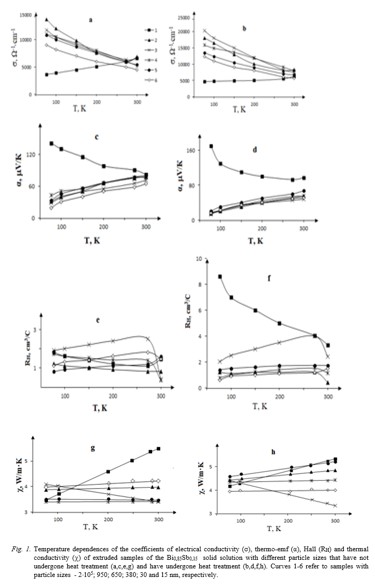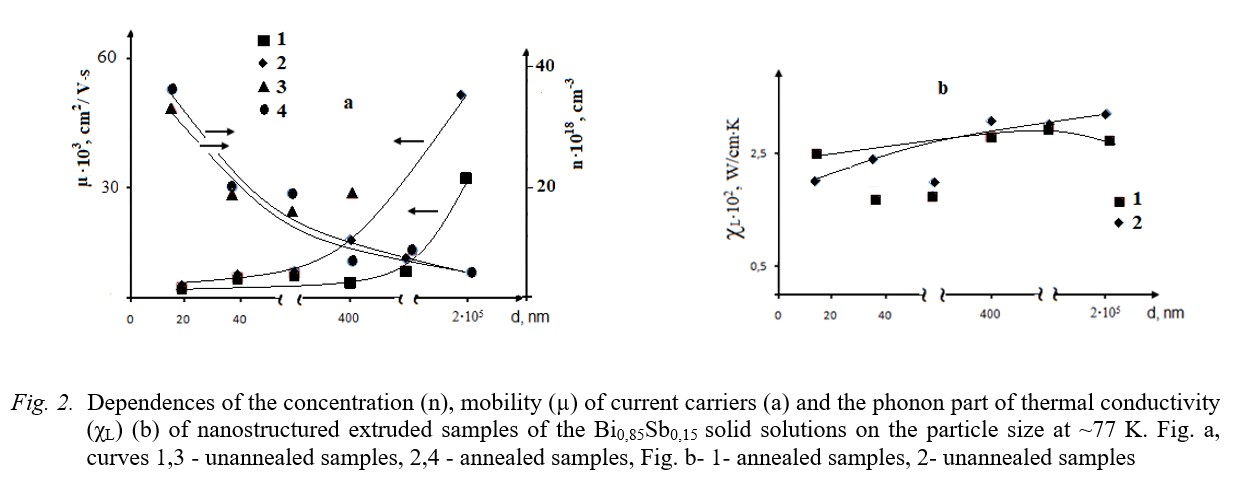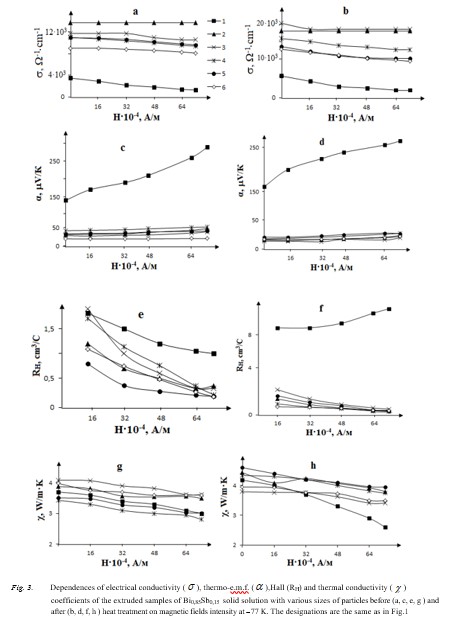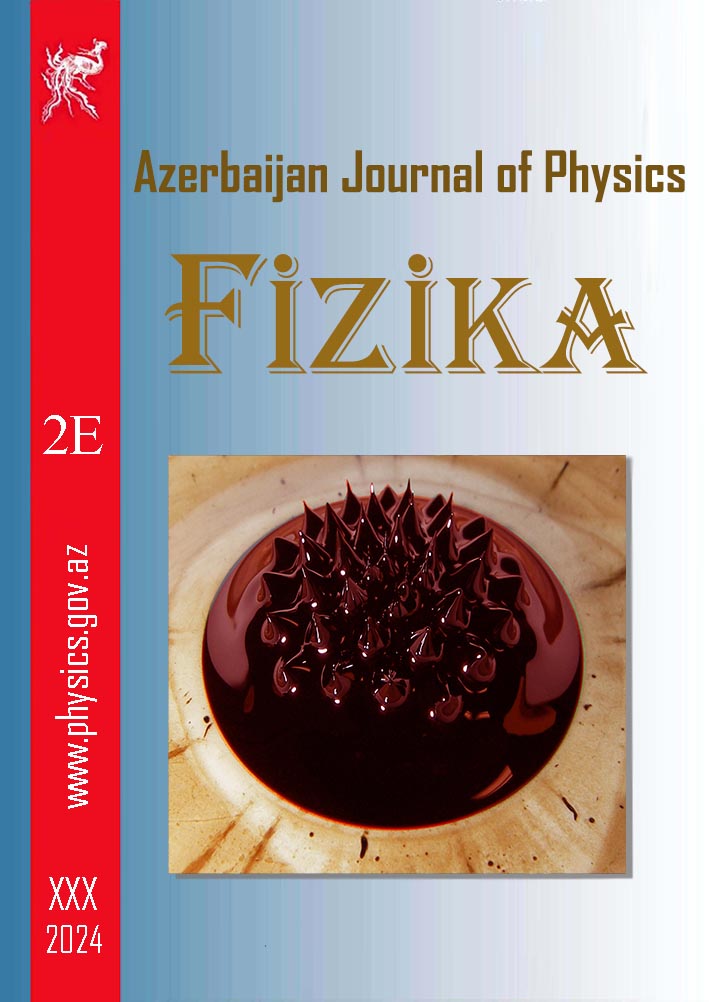ABSTRACT
Extruded bulk nanostructured samples of the Bi0,85Sb0,15 solid solution were obtained from particles with an average size of ~2105; 950; 650; 380; 30
and 15 nm and their thermoelectric properties were investigated in the range of ~77-300K. The samples that had not undergone heat treatment and the same samples that had
undergone heat treatment were examined. It was found that the electrical and thermal properties of the Bi0,85Sb0,15 solid solution samples significantly depend on the size
of nanoparticles and post-extrusion heat treatment. Heat treatment leads to a decrease in the concentration of current carriers, an increase in the mobility of current
carriers and the overall thermal conductivity of the studied samples, which is mainly due to the electronic component of thermal conductivity.
Keywords: extrusion, annealing, solid solution, nanoparticle, texture.
DOI:10.70784/azip.1.2024108
Received: 08.02.2024
Internet publishing: 27.06.2024
AUTHORS & AFFILIATIONS
1. Azerbaijan State Economic University, Baku city, Istiglaliyat str.,6. AZ-1001, Baku, Azerbaijan.
2. Institute of Physics named after G.B. Abdullaev Ministry of Science and Education. AZ-1143, H. Javid ave.,131, Baku, Azerbaijan.
3. Institute of Radiation Problems of the Ministry of Science and Education. AZ 1143, B. Vahabzade Ave., 9, Baku, Azerbaijan.
4. Azerbaijan Food Safety Institute. Suleyman Sani Akhundov 73C, Baku, Azerbaijan. AZ-1124.
E-mail: mail_tagiyev@mail.ru
Graphics and Images



Fig.1 Fig.2 Fig.3
|
REFERENCIES
[1] N.P. Stepanov. Electron–plasmon interaction in bismuth with an acceptor dopant. Russian Physics Journal. 2004. V.47. № 3. P. 262-272.
[2] M.M. Tagiyev. Influence of grain sizes and lead impurities on thermoelectric properties of extruded samples of Bi0.85Sb0.15 solid solution. Inorganic Mater. 2021. V. 57 (7). P. 113-118.
[3] M.M. Tagiyev. Electrical anisotropy in extruded specimens of Bi0.85Sb0.15 solid solution. Russian Physics Journal. 2018. V. 60 № 10. P. 1794-1797.
[4] N.A. Sidorenko, Z.M. Dashevsky. Effective Bi-Sb crystals for thermoelectric cooling at temperatures T ≤ 180 K. FTP. 2019. V. 53. Issue. 5. P.693-697.
[5] L.D. Ivanova, L.D. Petrova, V.Yu. Granatkina, V.S. Zemskov, et.al. Extruded materials for thermoelectriccoolers. Inorganic Mater. 2009. V.45. № 2. P.123-128.
[6] L.P. Bulat, l.V. Bochcov, I.A. Nefedova, R. Ahiska. Nanostructuring as a way to increase the efficiency of thermoelectric. Scientific and Technical Journal of Information Technologies, Mechanics and Optics. 2014. V. 4 № 92. P.48-56.
[7] B.Sh. Barkhalov, M.M. Tagiyev, G.Z. Bagiyeva, G.D. Abdinova, et.al. Effect of Grain Sizes on the Electrical and Thermal Conductivity of Extruded Bi0.5Sb1.5Te3 Solid Solution Samples. Russian Physics Journal. 2019. V. 62. №4. P. 664-672.
[8] V.A. Komarov, A.V. Suslov, M.V. Suslov. Galvanomagnetic properties of Bi85Sb15 thin films on different substrates. Semiconductors. 2017. V. 51. № 6. P. 702-705.
[9] L.P. Bulat, V.B. Osvencky, G.I. Pivovarov, A.A.Snarskii, E.V. Tatyanin, A.A.O. Tay. The influence of phonon thermal conductivity on thermoelectric figure of merit of bulk nanostructured materials with tunneling contacts. Proc. VI Eur. Conf. on Thermoelectrics. 2008. P.12-14.
[10] F.S. Samedov, M.M. Tagiyev, and D.Sh. Abdinov. Effect of heat treatment on the properties of extruded Pb-doped Bi0.85Sb0.15 solid solutions. Inorganic Mater. 1998. V. 34. № 7. P. 847-850.
[11] D.M. Heiker, L.S. Zevin. X-ray diffractometry, Moscow: Fizmatgiz 1963. 380. P.
[12] A.S. Okhotin, A.S. Pushkarsky, R.P. Borovikova, V.A. Smirnov. Methods for measuring the characteristics of thermoelectric materials and converters. M.: Science. 1974. 168. P.
[13] I.A. Smirnov, V.I. Tamarchenko. Electronic thermal conductivity in metals and semiconductors. L.: Science. 1977. 151. P.
[14] Л.П. Булат, В.В. Овсенский, Д.А. Пшенай-Северин. Влияние распределения зерен по размерам на решеточную теплопроводность наноструктурированных материалов на основе Bi2Te3-Sb2Te3. ФТТ. 2013. V. 55. № 12. P. 2323 -2330.
|
